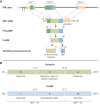A State of Natriuretic Peptide Deficiency
- PMID: 36346821
- PMCID: PMC10166265
- DOI: 10.1210/endrev/bnac029
A State of Natriuretic Peptide Deficiency
Abstract
Measurement of natriuretic peptides (NPs) has proven its clinical value as biomarker, especially in the context of heart failure (HF). In contrast, a state of partial NP deficiency appears integral to several conditions in which lower NP concentrations in plasma presage overt cardiometabolic disease. Here, obesity and type 2 diabetes have attracted considerable attention. Other factors-including age, sex, race, genetics, and diurnal regulation-affect the NP "armory" and may leave some individuals more prone to development of cardiovascular disease. The molecular maturation of NPs has also proven complex, with highly variable O-glycosylation within the biosynthetic precursors. The relevance of this regulatory step in post-translational propeptide maturation has recently become recognized in biomarker measurement/interpretation and cardiovascular pathophysiology. An important proportion of people appear to have reduced effective net NP bioactivity in terms of receptor activation and physiological effects. The state of NP deficiency both entails a potential for further biomarker development and could also offer novel pharmacological possibilities. Alleviating the state of NP deficiency before development of overt cardiometabolic disease in selected patients could be a future path for improving precision medicine.
Keywords: ANP; BNP; CNP; hypertension; natriuretic peptide; obesity.
© The Author(s) 2022. Published by Oxford University Press on behalf of the Endocrine Society.
Conflict of interest statement
Conflict of Interest M.N., T.P.L, N.B.M., S.Z.A., and M.E. are employees at Novo Nordisk. The company has no products relating to the current manuscript. J.P.G. has received an honorarium from Novo for advice on biomarker measurement. All other authors are university-affiliated and have no conflicts of interest to declare.
Figures






References
-
- Goetze JP, Bruneau BG, Ramos HR, Ogawa T, de Bold MK, de Bold AJ. Cardiac natriuretic peptides. Nat Rev Cardiol. 2020;17(11):698‐717. - PubMed
-
- Goetze JP. Coronary artery disease, heart failure, and cardiac natriuretic peptides in the middle. Eur Heart J. 2005;26(24):2603‐2604. - PubMed
-
- Suga S, Nakao K, Hosoda K, et al. . Receptor selectivity of natriuretic peptide family, atrial natriuretic peptide, brain natriuretic peptide, and C-type natriuretic peptide. Endocrinology. 1992;130(1):229‐239. - PubMed
MeSH terms
Substances
LinkOut - more resources
Full Text Sources
Medical
Research Materials
Miscellaneous

